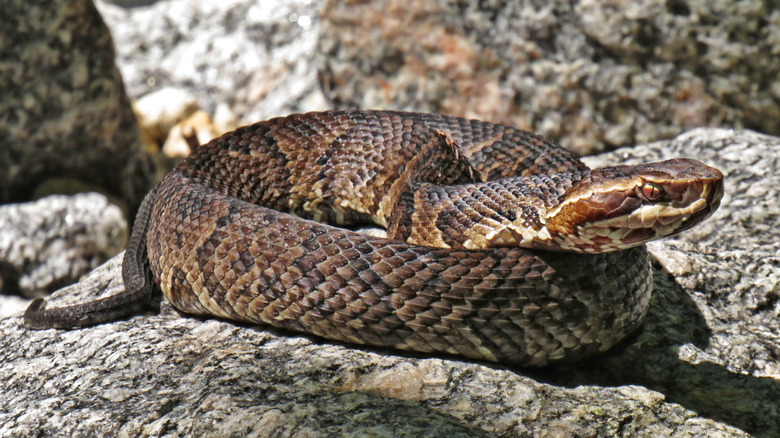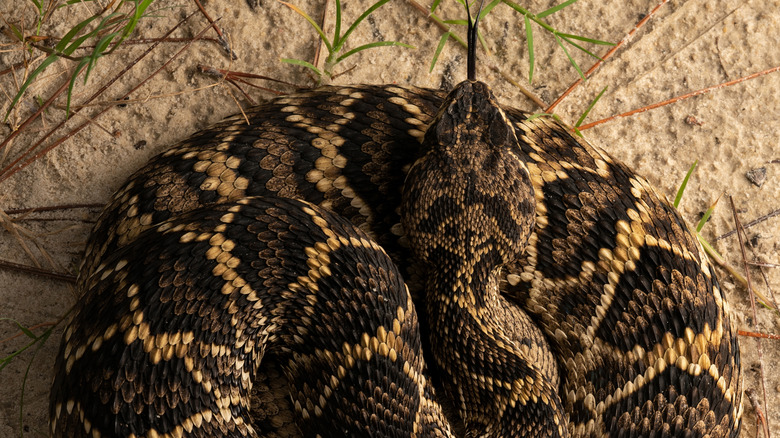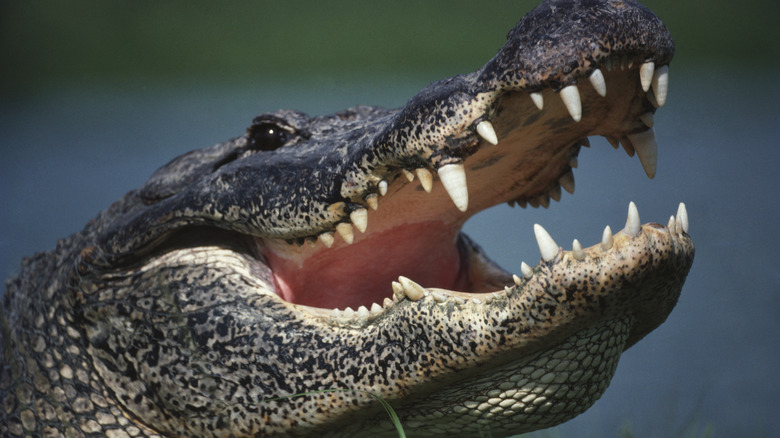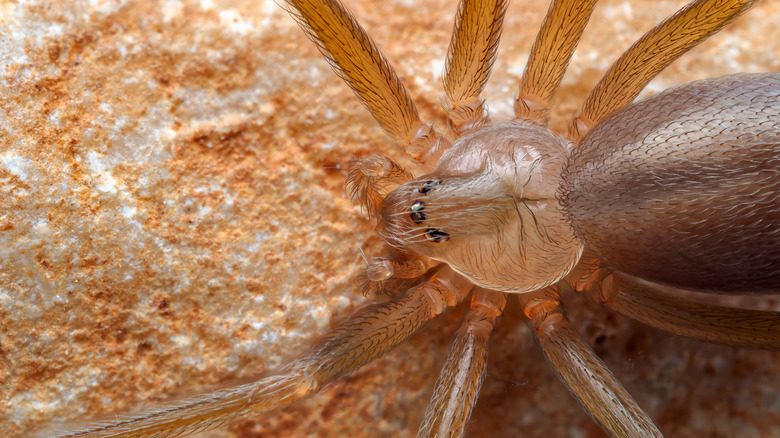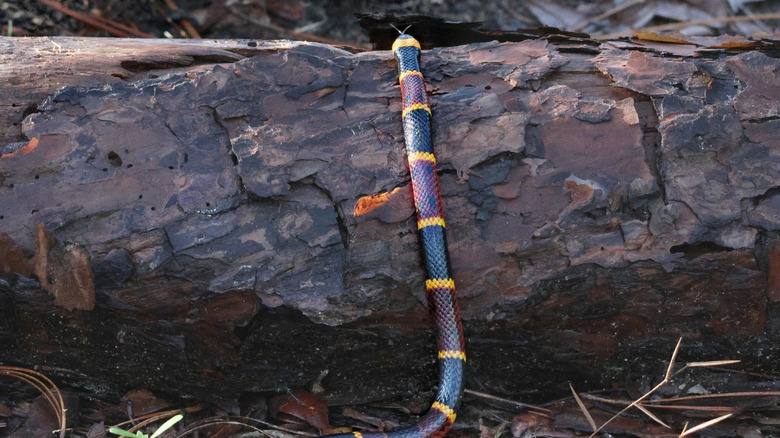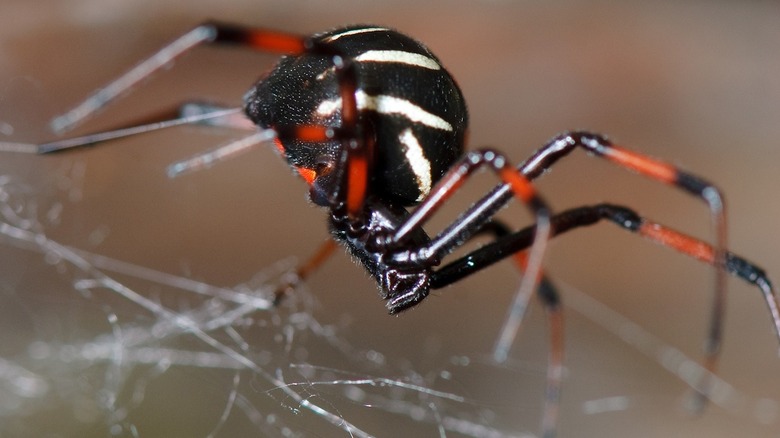5 Most Dangerous Animals In Georgia And Where You'll Likely Find Them
Don't get us wrong; Georgia is an amazing state spread over an incredible geography of plateaus, mountains, canyons, rivers, and coastal plains. But it's precisely because of its natural appeal that locals and visitors looking to get outdoors need to be aware of what they're potentially getting into. Georgia's diverse ecosystems are home to a variety of wildlife, and while they all contribute in their own way to the state's rich biodiversity and ecology, some pose significant risks to humans, even to the point of lethality.
That's not a theoretical worry, either. 2024 was one of the worst years on record for snakebites in the state, for example, which makes sense, seeing as Georgia is home to 47 different species of snake. And in July of that same year, a conspicuous mass gathering of alligators was reported in the canals of Okefenokee Swamp, prompting understandable concern from locals and interest from researchers wondering what caused the uncommon get together.
So if you're planning a trip to Georgia or you're just curious to know all the ways the state's fauna can put you in the hospital, you're in the right place. We'll take a look at the state's most dangerous animals — from snakes and alligators to spiders and other tiny critters that will ruin your day — and determine what makes them so hazardous to your health, where to find them, and, most importantly, what to do if you encounter any of them. But we'll also see why they're crucial to the ecosystems they are a part of, and touch on some facts that will hopefully let your curiosity override your fear. After all, the animal kingdom is a cool place. Let's dive in.
The eastern diamondback rattlesnake
If you're coming to Georgia, just know that you're coming to a state that has its fair share of snakes. Luckily, however, only seven of the 47 species that call the state home are venomous (fortunately, none of them are on our list of the 12 venomous species that can kill you in minutes). But there's no need to malign an already overmaligned creature — snakes play a valuable role in local ecosystems, and the odds of getting fatally bitten by a venomous snake are lower than getting struck and killed by lightning, so weigh your worry accordingly.
But the eastern diamondback rattlesnake is one of that special group of seven venomous snake species that you do need to keep in mind when you're outside in Georgia (with only the state's timber rattlesnake, cottonmouth, and eastern coral snake realistically representing a serious threat to human life). Thankfully, it's pretty easy to identify. As dangerous as it may be, the eastern diamondback just looks cool. It's a large, thick-bodied snake with diamond-shaped spots on its back, which can grow to be 7 feet long but average somewhere between 3 to 5 feet. They can be found mainly in the southern half of the state, where their population has been dwindling due to habitat loss and individuals killing them out of fear.
And while their venom (appropriately named hemotoxin) contains a potent toxin that destroys red blood cells and damages tissue, deaths are generally rare, given that its antivenom is widely available in areas where they're known to inhabit. Diamondbacks deserve your respect, not your fear. If you encounter one, follow the rule that you can apply to all rattlesnakes: stay calm and keep your distance, don't throw anything at it, and back away.
The American alligator
Few animals command the same level of awe and wariness as the American alligator, a species that has prowled the continent's wetlands, swamps, and rivers for millions of years. These prehistoric predators are truly awesome and are able to grow up to 16 feet long and weigh upwards of 800 pounds. In short, they are not to be messed with. They are the undisputed kings of Georgia's freshwater ecosystems, thriving in slow-moving rivers, marshes, and lakes, especially the Okefenokee Swamp, the Chattahoochee River, and the coastal plain region.
While attacks on humans are rare — there were only nine reported cases between 1980 and 2023 in the state, for example — when they do happen, they can be deadly. It's a good thing, then, that alligators are naturally wary of humans and will usually retreat when they encounter one. If you do stumble upon one, slowly back away. While exceedingly rare for them to give chase, don't mistake them for slowpokes — they can reach speeds of up to 35 miles per hour for short distances, even out of the water. And if you've ever heard of the infamous "death roll" technique alligators and crocodiles use to dismember and drown their prey, well, you get the idea.
And you don't want to end up in the jaws of one of the 200,000 gators that call Georgia home. American alligators have a bite force of over 2,000 pounds per square inch, the largest of any animal in the U.S. To put that in perspective, a lion has a bite force of "only" 600 pounds per square inch. But frightening as they look and deadly as they are, even alligators are beneficial to the environment, keeping the populations of the prey they consume in check and shaping habitats via their movements and behaviors.
The brown recluse spider
Georgia is home to its fair share of spiders, but few are as troublesome and unsettling as the brown recluse spider. Unlike other large, intimidating spiders, the brown recluse is a small, secretive, and venomous creature, making it one of the more feared spiders in the southeastern U.S.
The spider's special weapon is its cytotoxin-carrying venom that can result in necrotic sores that can spread quickly and don't easily heal. Usually, bites from the brown recluse will only result in these localized sores and almost never result in death, but they can cause severe muscle pain, nausea, and tissue death. If you do get bitten, use an ice pack to help lessen tissue damage and clean the area with soap and water. Seek medical attention immediately — while it's highly unlikely you'll be seriously injured from a bite, it's better to be safe than sorry.
Brown recluses generally prefer dark, undisturbed spaces like attics, basements, woodpiles, and even shoes and items of clothing left outside or in storage spaces. They're typically found in the northern portion of Georgia, having only been documented north of the Fall Line (an area of geographic transition separating the Piedmont and the Coastal Plain regions). If you encounter one, it will likely flee.
They can be identified by a couple of traits. First is the violin-shaped marking that stems off the back of their heads. The second is its eyes. Unlike most spiders, brown recluse spiders only have 6 eyes grouped in three pairs. Despite this, they can be challenging to identify and are easily mistaken for other non-venomous spiders, so take our advice and leave the spider, whatever species it is, alone. Trust us, there's a good reason why you shouldn't kill the spiders in your home.
The eastern coral snake
If you thought the eastern diamondback rattlesnake stood on business, wait until you meet the eastern coral snake, one of the most venomous reptiles in North America. They can be found mainly in the state's Coastal Plain region and in places along the Flint River basin. In general, they like to stick to sandy areas and open spaces, and will take refuge in animal burrows and downed logs, preferring to spend a majority of their time underground in dark hovels.
Here's how you identify one: simply remember the mnemonic phrase, "red touch black, venom lack; red touch yellow, kill a fellow." That morbid little reminder is to differentiate the eastern coral snake from the similarly colored but differently patterned scarlet snake. The snake has alternating rings of red, yellow, and black, with the red and black bands being wider than the thin yellow ones. And knowing the difference between the two can literally be life and death — eastern coral venom is highly toxic, affecting the central nervous system and potentially leading to paralysis, respiratory failure, and even death. Take our advice and avoid coming into contact with snakes in the wild no matter what they are.
Luckily, these snakes are shy and rarely bite unless provoked, so instances of serious injury and death are rare, accounting for less than 1% of all annual snakebites in the United States, according to the American College of Emergency Physicians. But if you are bitten (which can be difficult to assess, as these snakes may leave no bite or wound marking), seek medical attention quickly. Your best bet is to get a dose of North American coral snake antivenin, or NACSA, the only FDA-approved treatment for coral snake bites.
The black widow spider
The black widow is one of Georgia's most infamous venomous creatures. While it's a common misconception that the black widow is a singular species, there are several distinct varieties: the northern widow (Latrodectus variolus), southern widow (L. mactans), the western widow (L. hesperus), the brown widow (L. geometricus), and the red widow (L. bishopi). All but the western and red widow types are found in Georgia.
While it's wise to keep an eye on all of them, it's best to watch out for the northern widow, as it possesses venom that's 15 times stronger than that of rattlesnakes. Fatalities from a northern black widow bite are rare (usually occurring in children), but the toxin in its venom acts on the nervous system, resulting in muscle spasms, difficulty breathing, vomiting, and even seizures. If you suspect you've been bitten, seek immediate medical treatment. Your best bet for coming away from a black widow bite is to avoid getting bitten, which means knowing where they frequent and how to identify them.
The northern and southern widows are some of the most iconic spiders out there. The southern widow features a distinct red hourglass shape marking on its abdomen, while the northern variety displays a "broken" hourglass marking that's thin or disconnected in the middle, with some even featuring white stripes on their bodies. This spider usually hangs around cool, dark places. Garage sheds, woodpiles, stone walls, and outdoor furniture are all ideal spots for the black widow. Be cautious in dark, cluttered spaces, and leave the spider alone if you ever do see one. Donning gloves while doing garden and housework is never a bad idea, either. Despite their reputation, like all the animals on this list, they are not aggressive and will usually only bite when threatened.
